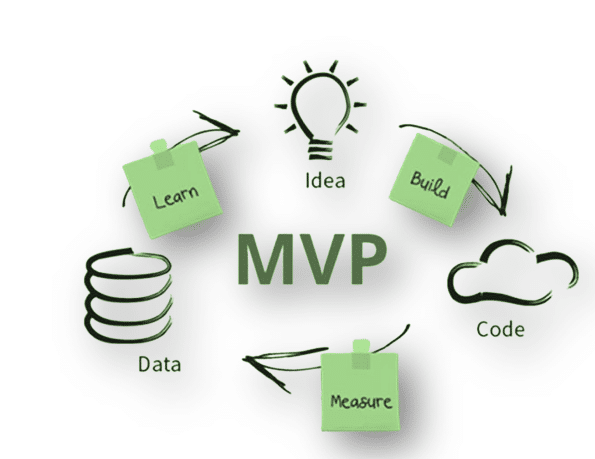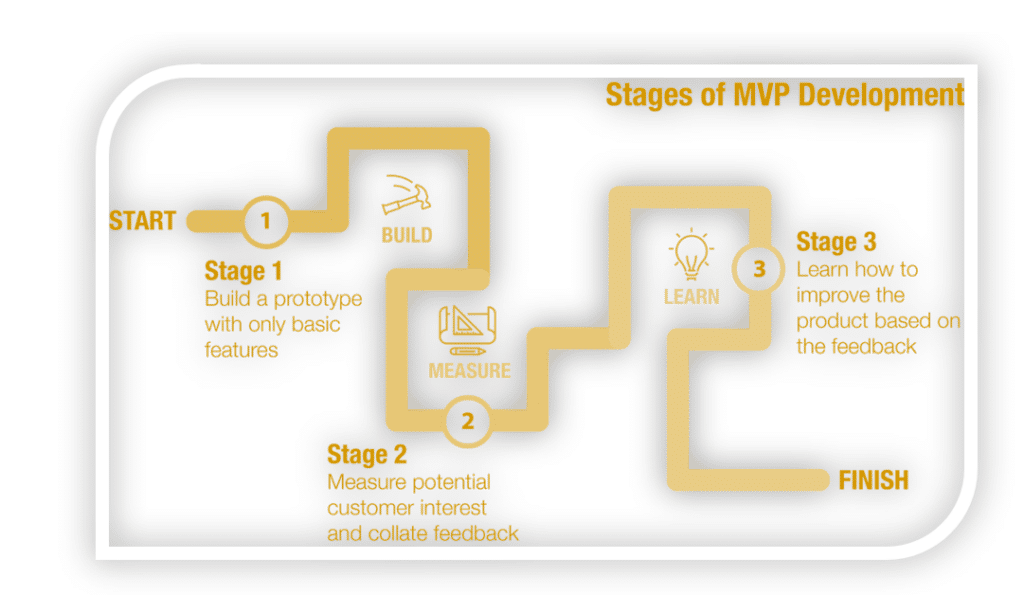Minimum Viable Product for Mobile App: Best Practices and Tips
The rise of startups gives a boost to a new term in the market known as “Minimum Viable Product (MVP)”. Let’s take a deeper dive and effectively figure out the prime benefits of MVP development.
The minimum viable product (MVP) allows business owners & startups to test their products at the early stages. Now, validation of ideas becomes easy by receiving early-stage user feedback.
Now, let’s read out all the essential details related to the MVP development process.
What is a Minimum Viable Product (MVP)?
A minimum viable product (MVP) allows you to test all the products and features before the launch of the products. It helps business owners to receive user feedback for iterating and improving the product.
It is a development strategy in which a new product or website is developed with enough features. The MVP concept allows a team to obtain valuable feedback from users on the product’s core features.
This feedback can then be used to make informed decisions about the direction of the final product. This approach allows companies to validate their product assumptions and identify potential problems early on.
It also helps in prioritizing features and understanding customer needs in a cost-effective way, reducing the risk of developing a product that no one wants.
What is the Purpose of Minimum Viable Product?

The purpose of MVP is to test and validate a product idea. You can devote significant time and effort before building a full-featured product.
- It allows companies to learn as quickly as possible what works and what doesn’t.
- It is a popular approach for startups and entrepreneurs.
- It is a development strategy that involves creating a basic version of a product with just enough features. So, satisfy early customers and provide valuable feedback for future development.
MVP is considered a tool for Agile development methodologies and it’s been widely adopted by startups and entrepreneurs as a way to validate their business idea before investing significant resources into it.
- Cost-effective validation: MVP development allows companies to validate their product assumptions and identify potential problems early on, without incurring significant costs.
- Prioritization of features: MVP mobile app development service helps an organization to understand which features are essential for their product and which can be deferred for later.
- Flexibility in development: MVP development allows companies to be more agile in their development process and adapt to changing market conditions.
- Unique and creative approach: MVP development encourages companies to think outside the box and come up with unique and creative solutions to problems.
Read more: PoC vs Prototype vs MVP: What to Choose?
Benefits of the MVP development company

The use of the MVP process will help an organization to effectively gain information about its targeted audiences. The use of MVP development allows companies to identify how their customers will be going to react after utilizing their product.
It sounds like a miracle right? Although, the Minimum Viable Product development services can commence many other miracles as well. Now, let’s check out the benefits of an MVP development company:
- Cost-effective validation: MVP allows companies to validate their product assumptions and identify potential problems early on, without incurring significant costs.
- Prioritization of features: MVP development helps companies understand which features are essential for their product and which can be deferred for later.
- Early feedback: MVP development provides companies with early feedback from customers and stakeholders, which can be used to improve the final product.
- Reduced risk: MVP development reduces the risk of developing a product that no one wants by validating the product idea with minimal investment.
- Faster time to market: MVP app development services allow companies to quickly get their product to market, which can be a significant advantage in highly competitive industries.
- Flexibility in development: MVP development allows companies to be more agile in their development process and adapt to changing market conditions.
- Increased customer satisfaction: MVP development helps in understanding customers’ needs and providing them with a solution that satisfies their needs, leading to increased customer satisfaction.
Tips & Tricks for the Minimum Viable Product Development
By focusing on the essential features, you can get your MVP to market faster and start gathering valuable feedback from users. A user-centered design approach and continuous testing and validation will help ensure that your MVP meets the needs of your users and keeps them engaged.
Now, let read out the foremost benefits of MVP development:
1. Keep the MVP simple
Start with a simple MVP that has only the core features that are essential for the product to function.
For example: one example of keeping the MVP simple is a company developing a new e-commerce platform. Instead of building out all the features of the platform at once, such as a loyalty program and personalized product recommendations, the company starts with just the core features of browsing and purchasing products.
This allows them to test the market and gather feedback from early adopters before investing significant resources into additional features. Once the company completed the core concept then they can decide whether the company should test further concepts or not?
2. Gather feedback early and often
Gather feedback from early adopters and stakeholders regularly to guide future development. An example of gathering feedback early and often is a company that’s developing a new mobile app for tracking fitness and health.
They start by releasing a basic minimum viable product version of the app that allows users to track their exercise and calories. They then gather feedback from early adopters through surveys, interviews, and user testing.
Based on this feedback, they make changes to the app, such as adding new features like tracking water intake and sleep and fixing any bugs. They continue to gather feedback at regular intervals throughout the development process to ensure that the app is meeting the needs of their users.
3. Prioritize features
Identify the most important features and focus on developing those first. The company can start by identifying the core features that are essential for the software to function, such as task assignment and tracking, deadline management and team collaboration.
These core features are then prioritized and developed first. Once the MVP is launched, they then gather feedback from early adopters and stakeholders to identify which additional features would be most valuable to them.
Based on this feedback – the company then prioritizes and develops the most important additional features, such as: the Gantt chart, time tracking and resource management.
4. Use lean development methodologies
Agile and Scrum are popular methodologies for MVP development because they allow for flexibility and quick iteration. For example: using lean development methodologies is a startup developing a new social media platform.
They use the Agile development methodology and Scrum framework to plan and execute their development process. They divide the work into small, manageable chunks called sprints, and at the end of each sprint, they review and reflect on their progress.
5. Test and measure
Use metrics to track the performance of the MVP and make data-driven decisions about future development. By testing and measuring the MVP, companies can make data-driven decisions about which features to prioritize, which design changes to make, and what areas need improvement.
Read more about : 9 Key Steps for Effective MVP Development: A Guide to Success
Common mistakes while selecting the MVP tricks & tips
To improve your organizational process for the MVP development, you need to pay an additional attention:
1. Not validating the product idea
One of the most common mistakes in minimum viable product software development is not validating the product idea before committing significant resources. For example: if you want to check 5 different business ideas through the MVP. So, in such cases, you are required to conduct a detailed manual check related to your idea.
The major concern is that if you will invest all of your resources into the app development process then it will be resultant in delivering an adverse impact on your application development process.
So, it is suggested that before MVP development – you should conduct a manual check to analyse whether all the ideas are worthwhile to test via minimum viable product development or not? Here, you need to understand that conducting a manual overview related to the ideas will be helpful for you to save your resources and to reduce the cost of MVP development.
2. Unproductive team members
The quality of your MVP development process gets heavily influenced on the bases of the team member’s productivity levels. So, make sure that the team members behind the development stage should be experienced.
3. Security Negligence
During the minimum viable product development process, it is important for you to avoid the entire security negligence. Security negligence can adversely affect your business data and it can even pull your users at high risk of exposure.
So, it is important that you should employ relevant security measures to strengthen your data. Although, data breaches are serious incidents that can hamper processes.
Thus, hire companies who are able to provide you with profound security over your business data.
Read more: Minimum Viable Product Case Studies
The Final Words
We hope that all these tips and tricks will help you to effectively anticipate reasonable business solutions. At Amplework, we have a team of experienced developers who can help you in developing profound minimum viable product solutions. You can connect with us to experience reliable and result-oriented solutions.



 sales@amplework.com
sales@amplework.com
 (+91) 9636-962-228
(+91) 9636-962-228





